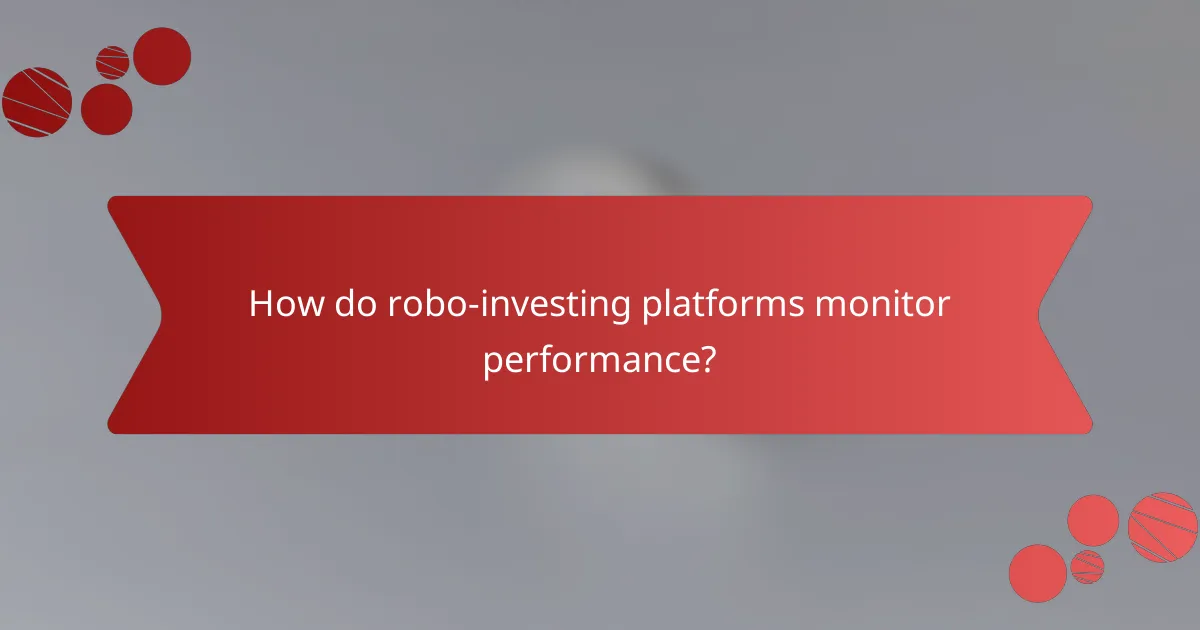Robo-investing solutions provide automated investment management that aligns with individual financial goals and risk tolerance. By utilizing advanced algorithms, these platforms assess risk, determine optimal asset allocation, and continuously monitor performance, ensuring that users can grow their investments effectively and efficiently.

What are the best robo-investing solutions available in the US?
The best robo-investing solutions in the US offer automated investment management tailored to individual financial goals and risk tolerance. These platforms typically provide features like risk assessment, asset allocation, and performance monitoring to help users grow their investments efficiently.
Wealthfront
Wealthfront is a popular robo-advisor that focuses on tax-efficient investing and automated financial planning. It uses a goal-based approach, allowing users to set specific financial objectives, such as retirement or buying a home, and then creates a personalized investment strategy.
One of Wealthfront’s key features is its tax-loss harvesting, which can help minimize tax liabilities. The platform charges a low annual fee, typically around 0.25% of assets under management, making it an affordable option for many investors.
Betterment
Betterment is another leading robo-investing platform that emphasizes personalized financial advice and goal tracking. It offers features like automatic rebalancing and tax-loss harvesting, similar to Wealthfront, but also provides access to human financial advisors for more complex questions.
Betterment’s fee structure is competitive, generally around 0.25% to 0.40% of assets, depending on the account type. Users can choose from various investment strategies based on their risk tolerance, making it suitable for both conservative and aggressive investors.
SoFi Invest
SoFi Invest combines robo-advising with a user-friendly interface and additional financial services like student and personal loans. It offers automated investing with no management fees, making it an attractive option for those looking to minimize costs while still benefiting from professional asset allocation.
SoFi Invest allows users to invest in ETFs and stocks, providing a more hands-on approach if desired. The platform also includes educational resources to help users understand investing better, which can be particularly beneficial for beginners.

How do robo-investing solutions assess risk?
Robo-investing solutions assess risk by evaluating an investor’s financial situation, goals, and preferences. This process typically involves algorithms that analyze various factors to determine the appropriate investment strategy tailored to individual risk profiles.
Risk tolerance questionnaires
Risk tolerance questionnaires are essential tools used by robo-investing platforms to gauge an investor’s willingness and ability to take on risk. These questionnaires often include questions about investment goals, time horizon, and reactions to market fluctuations.
Investors typically answer questions on a scale, which helps the algorithm categorize them into risk profiles such as conservative, moderate, or aggressive. For example, a conservative investor may prefer a portfolio with a higher allocation to bonds, while an aggressive investor might favor stocks.
Portfolio simulations
Portfolio simulations use historical data and market scenarios to predict how different investment strategies might perform under various conditions. Robo-advisors run these simulations to assess potential risks and returns for each portfolio configuration.
By analyzing factors such as market volatility and economic trends, these simulations help investors understand the potential outcomes of their investment choices. For instance, a simulation might show that a balanced portfolio could yield moderate returns with lower risk compared to a high-risk, high-reward strategy.

What is the asset allocation strategy used by robo-investors?
The asset allocation strategy employed by robo-investors typically involves diversifying investments across various asset classes to optimize returns while managing risk. This strategy is guided by algorithms that analyze individual investor profiles, including risk tolerance and investment goals.
Modern Portfolio Theory
Modern Portfolio Theory (MPT) is a foundational concept in asset allocation that emphasizes the benefits of diversification. According to MPT, a well-constructed portfolio can achieve higher returns for a given level of risk by combining different asset classes, such as stocks, bonds, and real estate.
Robo-investors utilize MPT to create portfolios that balance risk and return. For example, a conservative investor might have a higher allocation in bonds, while an aggressive investor might lean more towards equities. The goal is to find the optimal mix that aligns with the investor’s risk profile.
Dynamic asset allocation
Dynamic asset allocation is a strategy that involves adjusting the asset mix in response to changing market conditions and economic indicators. Robo-investors frequently employ this approach to capitalize on market trends and mitigate potential losses.
For instance, if market volatility increases, a robo-advisor might reduce exposure to equities and increase allocations to safer assets like cash or bonds. This proactive adjustment helps maintain the desired risk level and can enhance long-term performance. Investors should be aware that while dynamic allocation can improve returns, it may also lead to higher transaction costs.

How do robo-investing platforms monitor performance?
Robo-investing platforms monitor performance through automated systems that track investment returns and portfolio health in real-time. These platforms utilize algorithms to analyze data and provide insights, ensuring that investors are informed about their financial progress.
Automated performance tracking
Automated performance tracking is a key feature of robo-investing platforms, allowing users to see how their investments are performing without manual input. These systems typically provide dashboards that display metrics such as return on investment (ROI), asset growth, and comparisons against market benchmarks.
Investors can expect updates on performance at regular intervals, often daily or weekly. This frequent monitoring helps identify trends and allows for timely adjustments to investment strategies if necessary.
Regular portfolio rebalancing
Regular portfolio rebalancing is essential for maintaining an investment strategy aligned with an investor’s risk tolerance and financial goals. Robo-investing platforms automatically adjust asset allocations based on predefined criteria, such as target percentages for different asset classes.
This process typically occurs quarterly or semi-annually, but some platforms offer more frequent rebalancing. By keeping the portfolio in line with the desired allocation, investors can manage risk more effectively and potentially enhance returns over time.

What criteria should you consider when choosing a robo-investing platform?
When selecting a robo-investing platform, consider factors such as fees, investment options, and performance monitoring features. These criteria will help ensure that the platform aligns with your financial goals and investment strategy.
Fees and commissions
Fees and commissions can significantly impact your investment returns over time. Look for platforms that offer transparent pricing structures, including management fees, trading commissions, and any additional costs associated with account maintenance.
Many robo-advisors charge annual management fees that typically range from 0.25% to 1% of assets under management. Some platforms may also have additional fees for specific services or fund expenses, so it’s essential to read the fine print.
Investment options
The variety of investment options available on a robo-investing platform can influence your portfolio diversification. Most platforms offer a mix of asset classes, including stocks, bonds, and ETFs, but the specific offerings can vary widely.
Consider whether the platform provides access to socially responsible investments, tax-efficient funds, or alternative assets. A broader selection can help you tailor your investment strategy to meet your personal values and financial objectives.

How do robo-investing solutions compare to traditional investing?
Robo-investing solutions typically offer a more automated and algorithm-driven approach compared to traditional investing, which often relies on human advisors. This technology-driven method can lead to lower costs and increased efficiency in managing investments.
Cost-effectiveness
Robo-investing solutions are generally more cost-effective than traditional investment methods. They often charge lower management fees, typically ranging from 0.25% to 0.75% of assets under management, compared to the 1% to 2% fees common with human advisors. This difference can significantly impact long-term investment returns.
Additionally, robo-advisors usually have lower account minimums, allowing investors to start with smaller amounts, often as low as $500 or even $0 in some cases. This accessibility can help individuals begin investing without a substantial upfront commitment.
Accessibility
Robo-investing solutions provide greater accessibility for a wider range of investors. They are available online and through mobile apps, allowing users to manage their portfolios anytime and anywhere. This convenience is particularly beneficial for younger investors who are more accustomed to digital platforms.
Moreover, robo-advisors often offer educational resources and tools that help users understand investment strategies and market trends. This can empower novice investors to make informed decisions without needing extensive financial knowledge or experience.


